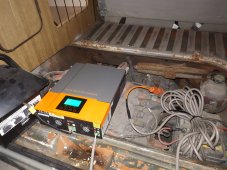You are saying that with a bidirectional charger supporting HVDC out, you can feed that into an HV MPPT of a hybrid inverter I rented to connect to a solar string and is will successfully charge a 48V battery at whatever maximum charge power it supports???
Has anyone done that?
By the end of the thread, this guy got a cheap hybrid with 48V worth of car batteries drawing from HV EV battery into PV MPPT input, and operating his Skilsaw.
The property is off grid using a Prius as a generator to power an off grid tiny home Inverter being used: Aurora PVI6000 Prius traction battery voltage: 220 DC Ran wire from Prius to pvi6000 Inverter turned on and said "Missing Grid" This is grid tie inverter and needs to be connected to...

diysolarforum.com
The missing piece is transferring PV to car battery. So I suggest actual PV into other PV MPPT input, and inverter feeds vehicle charger when desired.
Issue with HV EV battery feeding MPPT would seem to be that if you have battery and actual PV connected, you want to draw from PV first, only drain EV battery if necessary.
So what requirements might there be on an HV MPPT string input needed to allow it to function with an HVDC output from a bi-directional charger?
Maybe its algorithm? Some just have PV MPPT function. Some are constant voltage, or otherwise adapted to fuel cell, hydro, wind.
I'm not sure how you control the bidirectional charger. He connected battery directly.
I would be concerned with precharge inrush using battery directly. Also fault current. (Sunny Boy Storage specifies 30A max available current to its battery inputs, and their supported batteries, some models at least, are lower voltage battery with boost converter. Not direct battery.




